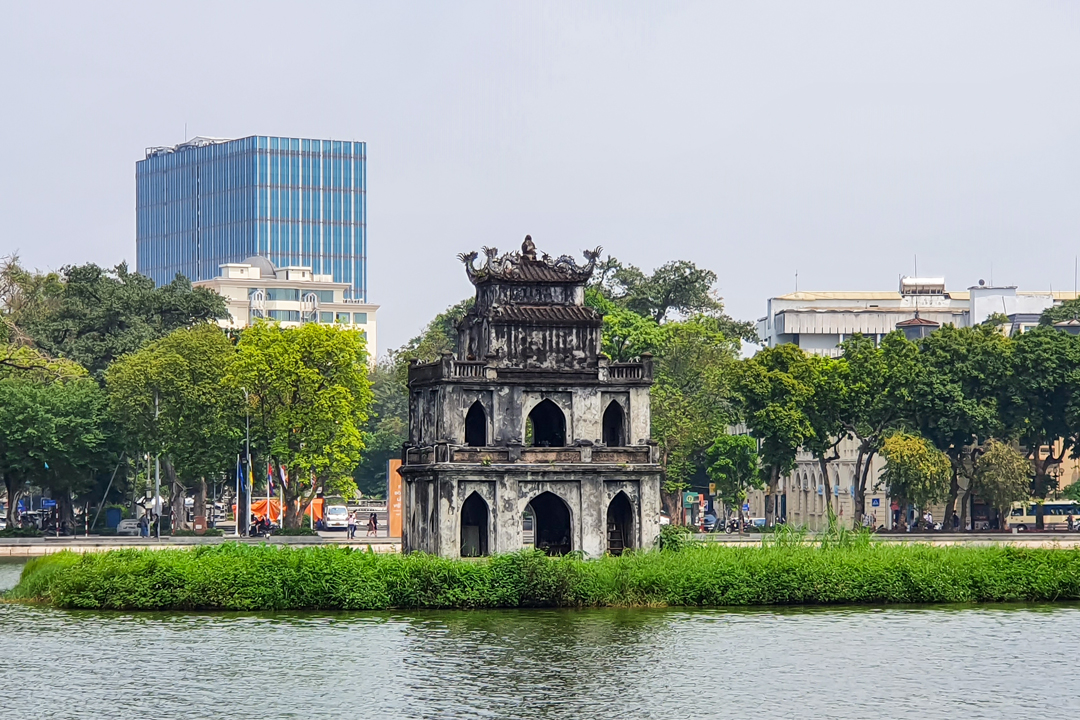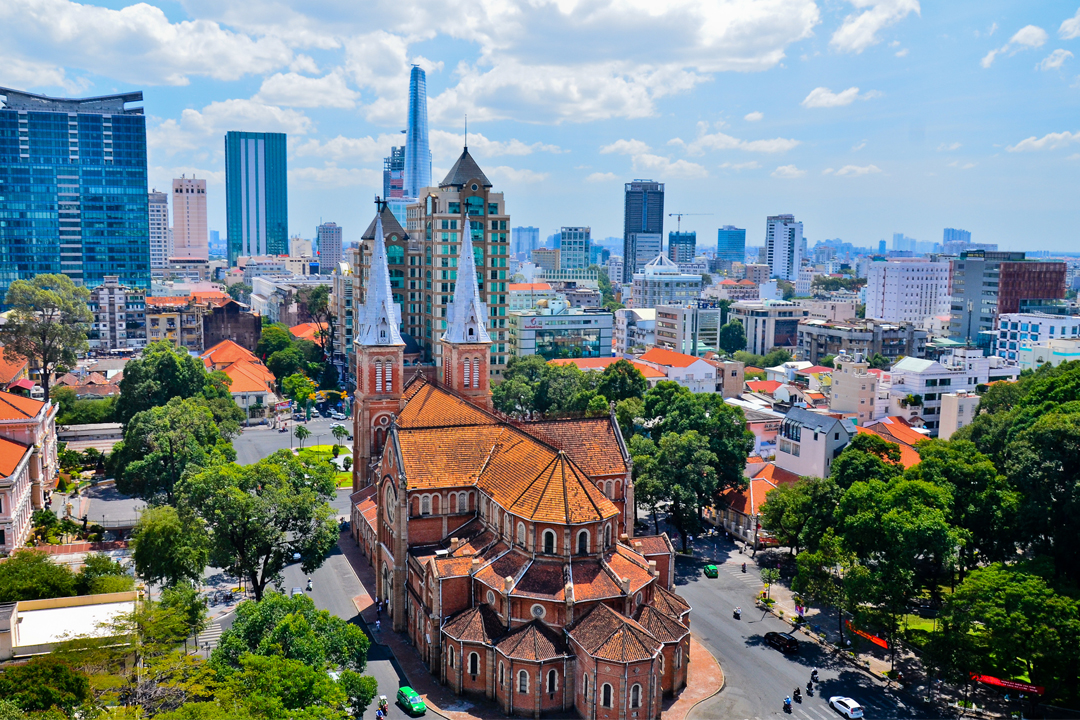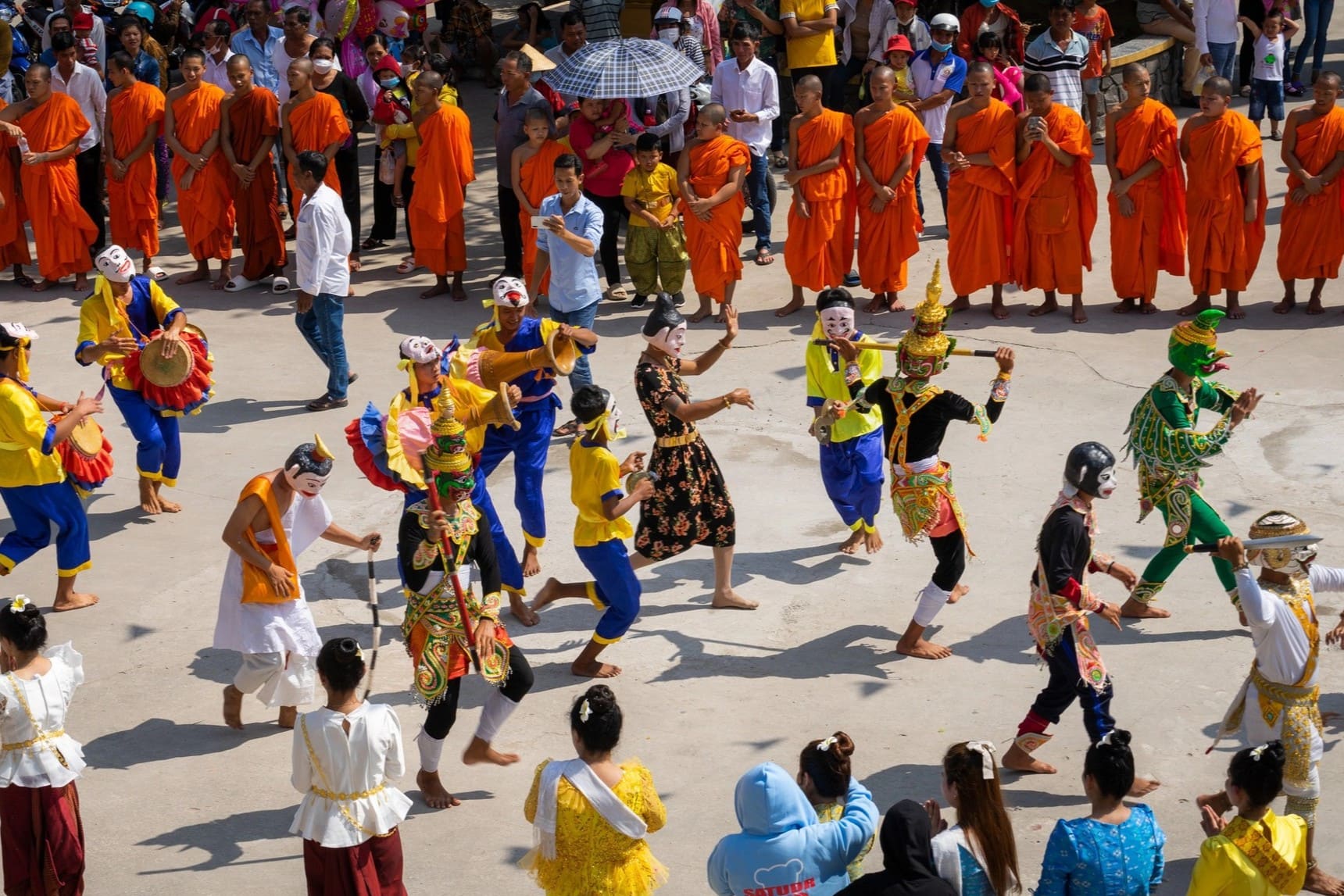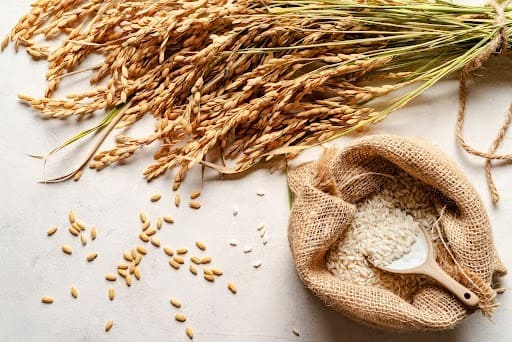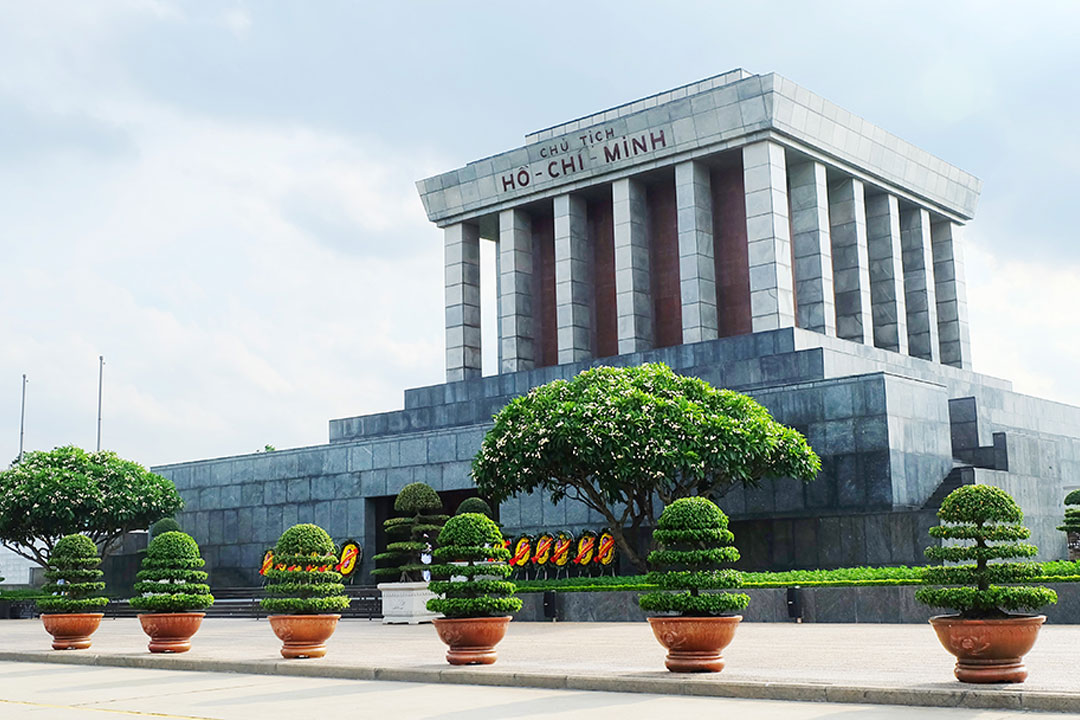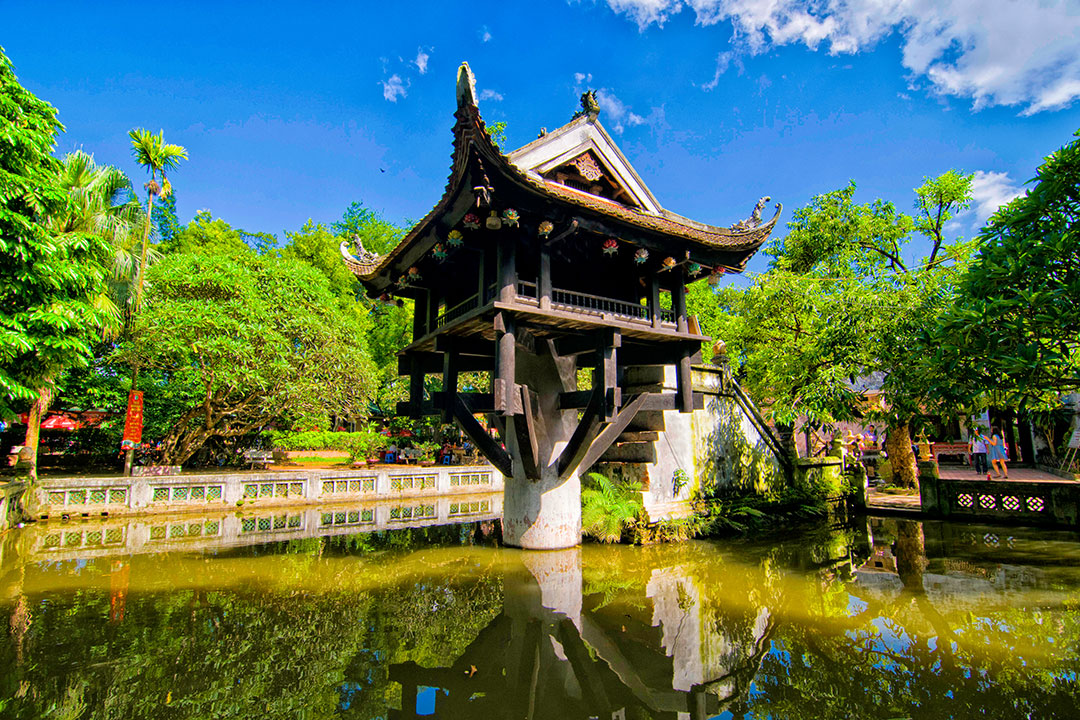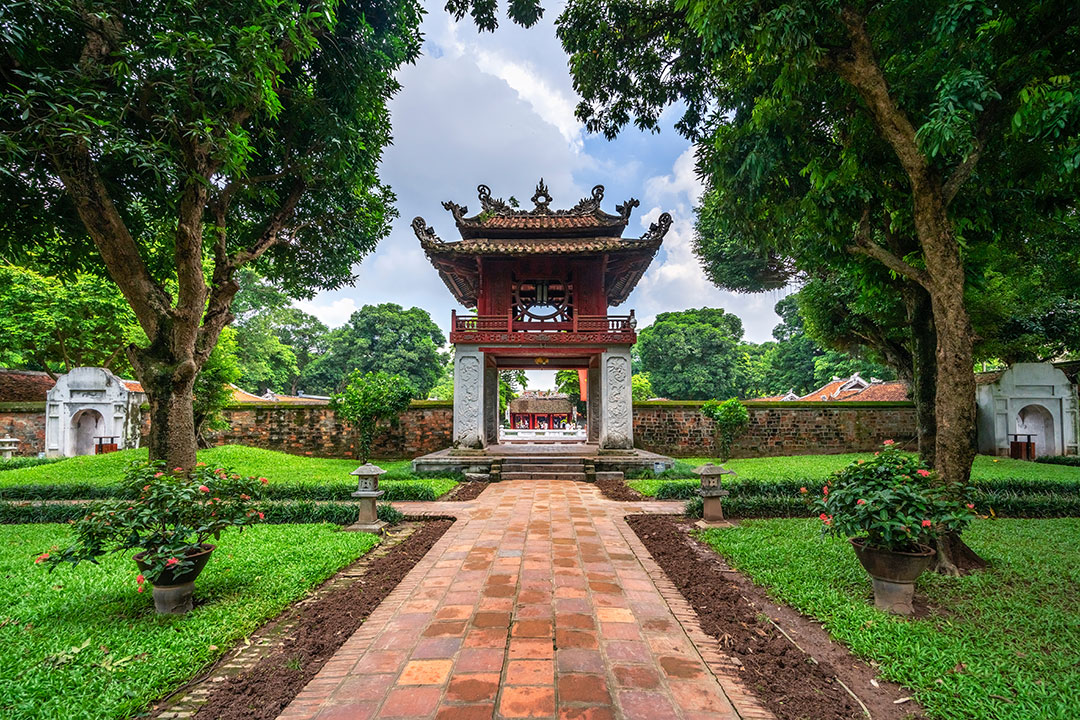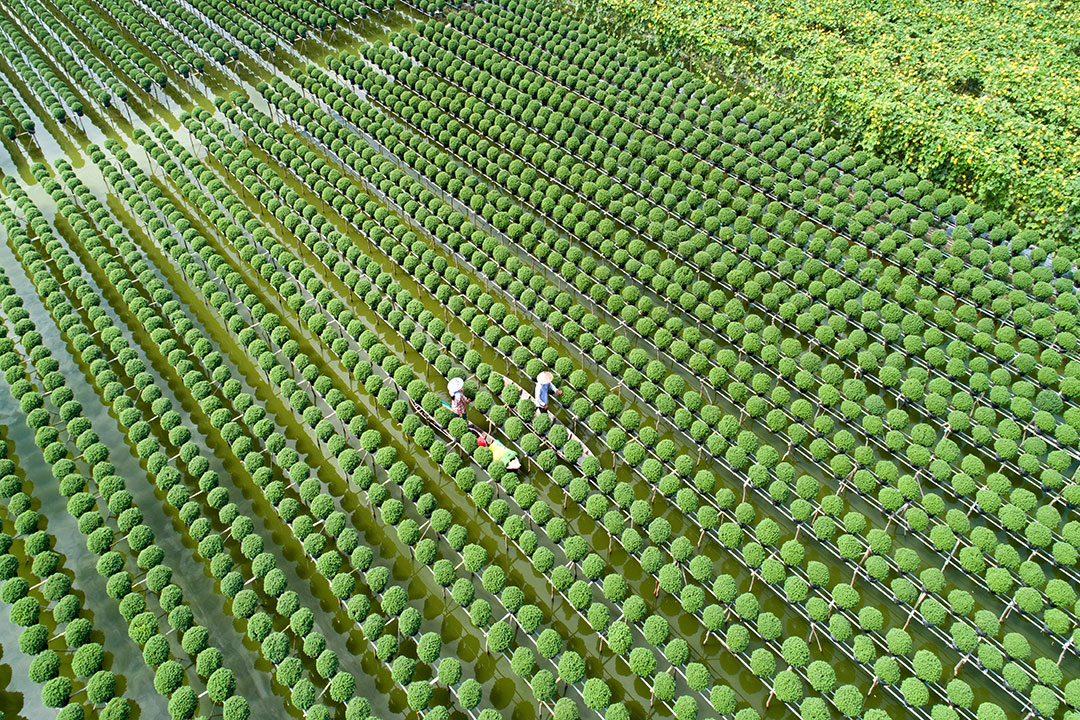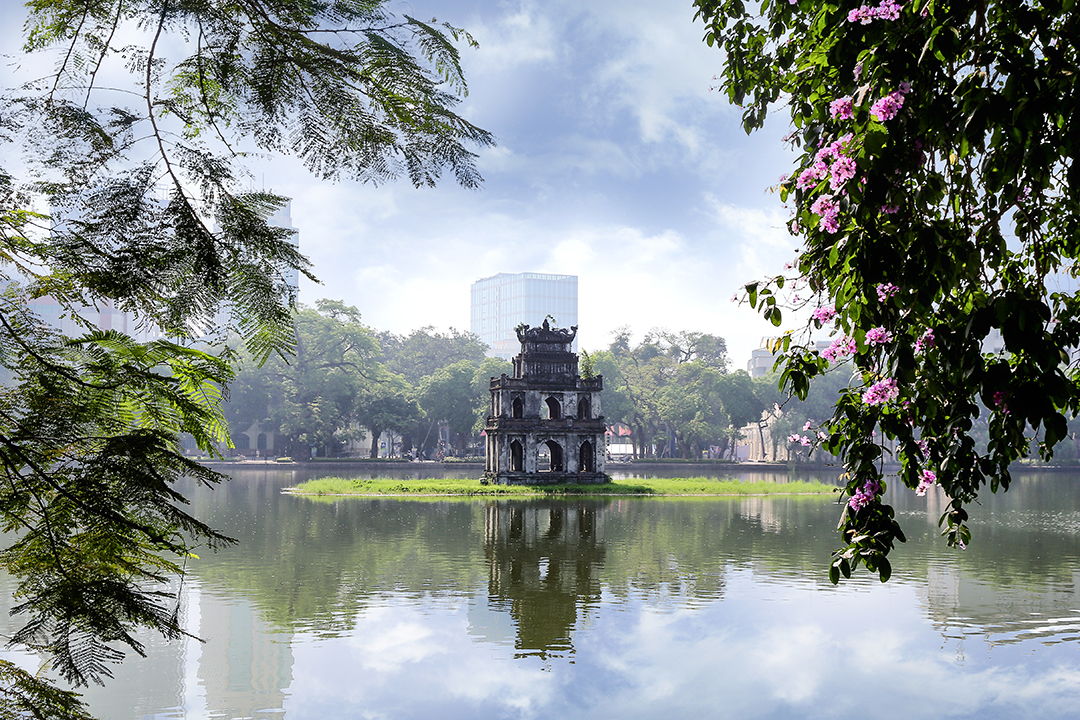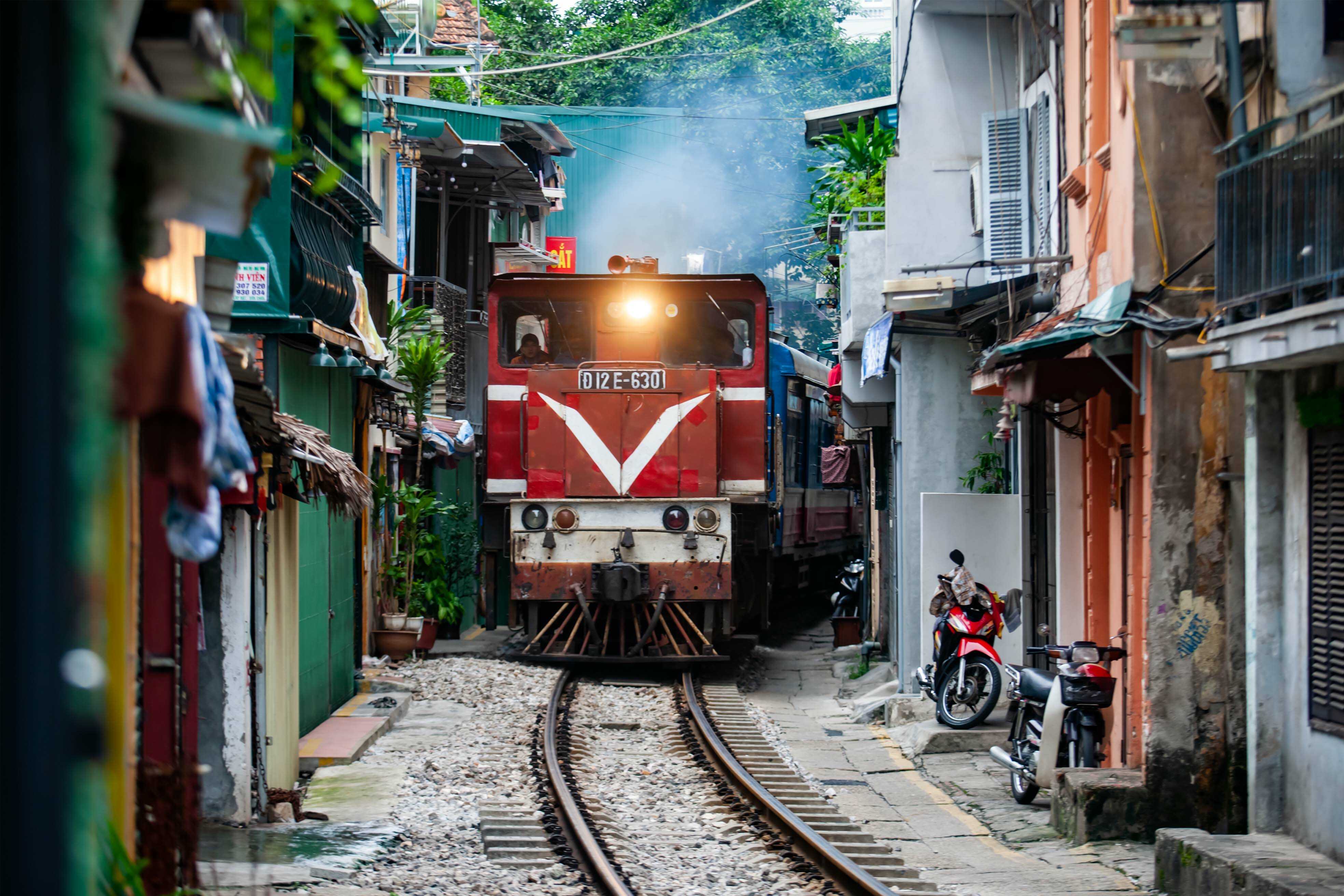Vietnam National Fine Arts Museum: Ticket Fee, History, Architecture, Things To Do & Important Notes
Discovering Vietnam's rich tapestry of culture and history isn't complete without a visit to the Vietnam National Fine Arts Museum. Nestled in Hanoi, this hidden gem captures the essence of Vietnamese artistic evolution across centuries. For deeper insight into the nation’s soul, exploring its art reveals society’s shifts and resilience over time.
This article by GTrip will illuminate key highlights within the museum, offering tips for an enriching experience while unveiling hidden narratives that resonate beyond borders. If you're an avid art enthusiast or a curious traveler, understanding why this cultural haven is pivotal can enhance your appreciation for Vietnam’s intricate artistry and heritage.
Necessary information about Vietnam National Fine Arts Museum
Before exploring Vietnam's artistic heritage, visitors should know essential details about the Vietnam National Fine Arts Museum. This section covers location information, opening hours, and admission fees to help you plan your visit efficiently.
Where is the Vietnam National Fine Arts Museum located?
Location: 66 Nguyen Thai Hoc Street, Ba Dinh Ward (66 Nguyen Thai Hoc Street, Dien Bien Ward, Ba Dinh District, Hanoi)
The Vietnam National Fine Arts Museum (Bao tang My thuat Viet Nam) is centrally situated in Hanoi’s former Ba Dinh District. This prime location places it within walking distance of several historical attractions, including the Temple of Literature and the Vietnam Military History Museum.
The museum operates from Tuesday to Sunday, with daily opening hours from 8:30 AM to 5:00 PM. Please note that the museum is closed every Monday for maintenance, so plan your itinerary accordingly. The museum typically experiences smaller crowds during weekday mornings, making this an ideal time for those seeking a more intimate viewing experience.
For travelers wishing to optimize their visit, the museum's two connected buildings are easily navigable within 1.5 to 2 hours. Art enthusiasts, however, may want to allocate extra time to fully appreciate the extensive collection spanning multiple centuries of Vietnamese artistic development.
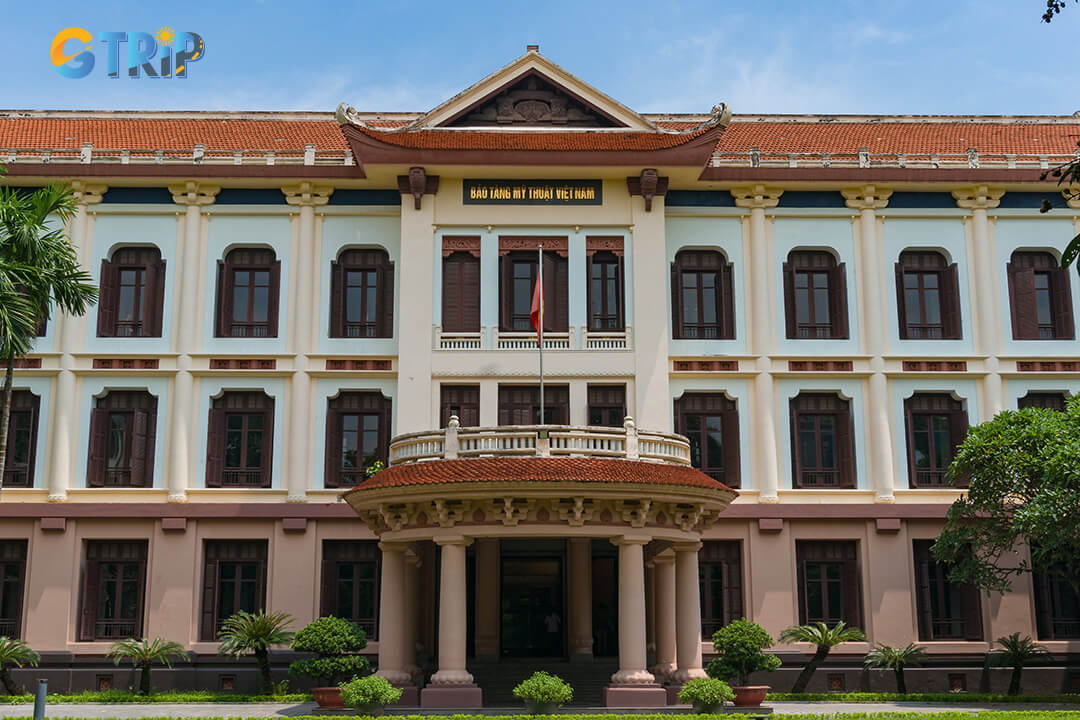
Vietnam National Fine Arts Museum offers an easily accessible and enriching art experience just steps from key historical landmarks
Ticket price
The Vietnam National Fine Arts Museum offers various ticketing options to accommodate different visitor needs and enhance the museum experience.
| Service | Adults | Students | Children, students aged 6 - 16 | Notes |
|---|---|---|---|---|
| Admission ticket | 40,000 VND/ticket | 20,000 VND/ticket | 10,000 VND/ticket | |
| Guided tour | 150,000 VND/group | Max 25 people per group | ||
| iMuseum VFA audio guide | 50,000 VND/ticket | 30,000 VND/ticket | Supports Vietnamese, English, French, Spanish, German, Italian, Japanese, Korean, Chinese | |
| Creative space experience | 50,000 VND/ticket | For children aged 5 - 15 |
The basic admission fees are quite affordable compared to international art museums, making it accessible for budget travelers. Children under 6 years old enjoy free entry, while students receive significant discounts with valid identification.
For a more enriching experience, consider these additional services:
- The guided tour option provides insightful commentary for larger groups (ideal for families or travel companions)
- The multilingual audio guide offers detailed explanations of key exhibits in nine different languages
- The Creative Space Experience provides interactive artistic activities specifically designed for young visitors
The history of the Vietnam National Fine Arts Museum
The Vietnam National Fine Arts Museum boasts a fascinating history that blends colonial influence with Vietnamese cultural preservation. The distinctive building began its life in the 1930s as a school for the daughters of French colonial officials during the French occupation of Vietnam. Its original architecture reflected the French colonial style that was prevalent throughout Indochina during this period.
In 1962, the building underwent significant renovations to transform it from an educational institution into a cultural treasure house. The renovation carefully preserved the colonial-era charm while adapting the space to showcase Vietnam's rich artistic heritage. This renovation blended European architectural elements with traditional Vietnamese design features, creating a unique aesthetic that symbolizes Vietnam's complex cultural history.
The museum officially opened its doors to the public in 1966, marking an important milestone in Vietnam's cultural development. At its opening, the facility encompassed a total area of 4,200 m², with 1,200 m² dedicated specifically to exhibition space. This allowed the museum to display a significant collection of Vietnamese prehistoric artworks and cultural artifacts for the first time in a dedicated national institution.
Between 1997 and 1999, the museum underwent a major expansion to accommodate its growing collection and increasing visitor numbers. This expansion increased the total area to 4,737 m², with exhibition space more than doubling to 3,000 m². This renovation enabled the museum to better showcase the breadth and depth of Vietnamese artistic expression from prehistoric times to the contemporary era.
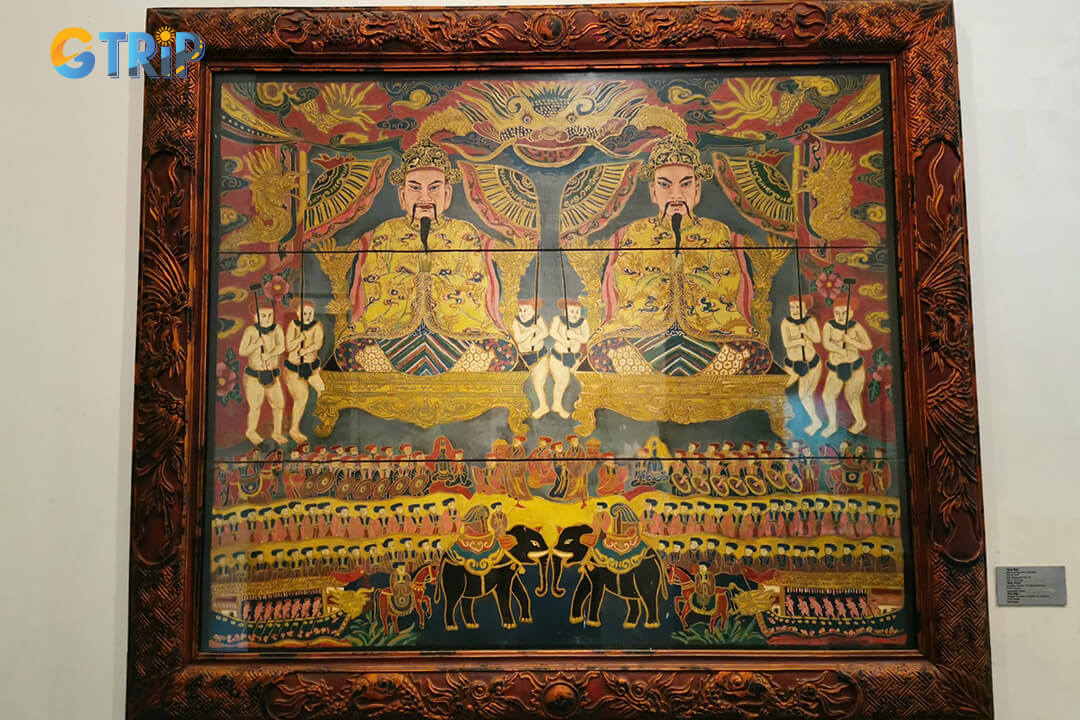
Vietnam National Fine Arts Museum opened in 1966 and now showcases Vietnamese art in a building that blends French and traditional architecture
The structure of the Vietnam National Fine Arts Museum
The Vietnam National Fine Arts Museum is housed in a remarkable building that showcases a harmonious blend of architectural styles. Built in French colonial style, the building now blends traditional Vietnamese architectural elements through later renovations. The resulting structure represents a seamless marriage of European grandeur and Vietnamese aesthetic sensibilities, creating a fitting home for the country's artistic treasures.
Visitors to the museum will appreciate the spacious exhibition halls that allow artworks to breathe and be properly appreciated. Natural light floods many galleries through strategically placed windows, creating an inviting atmosphere for art appreciation. The building is complemented by beautifully landscaped gardens that provide peaceful spaces for reflection between viewing sessions and add to the overall visitor experience.
The museum's impressive infrastructure includes a specialized storage area spanning 1,000 square meters, divided into 8 purpose-built rooms. Each storage room is designed to house different types of artefacts under optimal preservation conditions, ensuring the longevity of Vietnam's cultural heritage. The climate-controlled environments maintain specific temperature and humidity levels appropriate for different artistic mediums and historical periods.
Exhibition space at the museum extends across 3,000 square meters, distributed among multiple galleries on different floors. This generous allocation allows for comprehensive permanent displays while also accommodating rotating special exhibitions. The layout encourages a natural flow between different periods and styles of Vietnamese art, creating a cohesive narrative journey for visitors.
Behind the scenes, a dedicated collection management department oversees nearly 20,000 objects in the museum's holdings. Of these, approximately 18,000 items are kept in the specialized storage facilities, while about 2,000 carefully selected pieces are on public display at any given time. This rotation system allows for collection preservation while ensuring visitors always have access to representative masterpieces.
The museum's collections are organized into several distinct categories:
- Fine Art Mediums
- Ancient and modern Vietnamese sculptures
- Oil paintings showcasing both Western influence and local themes
- Traditional lacquer paintings demonstrating unique Vietnamese techniques
- Delicate artworks on paper and silk
- Historical Collections
- Traditional arts and ancient ceramic vessels
- Specialized Cu Lao Cham ceramics from underwater archaeological discoveries
- Prehistoric artifacts, including tools, weapons, and ceremonial figurines
- Folk paintings and statues representing regional traditions
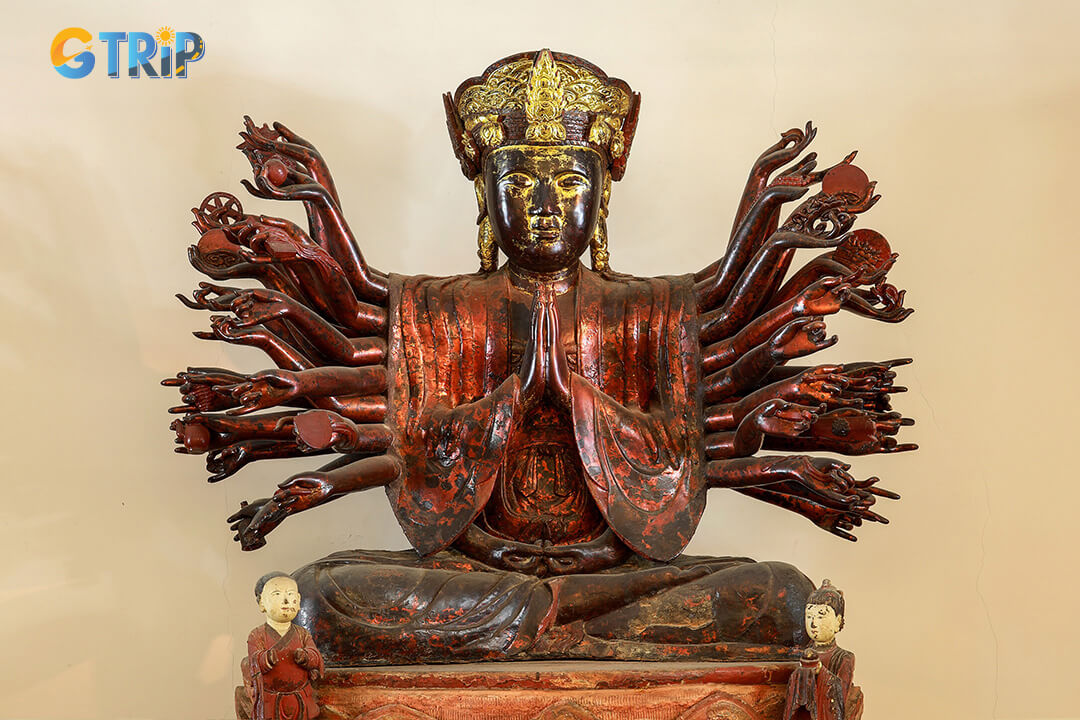
The Vietnam National Fine Arts Museum combines colonial and traditional design, featuring spacious galleries and a rich collection of nearly 20,000 artworks
The exhibitions to explore at the Vietnam National Fine Arts Museum
The Vietnam National Fine Arts Museum houses an impressive collection spanning Vietnam's artistic timeline from prehistory to contemporary works. With over 20,000 artifacts, the museum showcases Vietnamese art across mediums and eras. The museum balances permanent collections highlighting Vietnam's rich cultural heritage with rotating temporary exhibitions that showcase modern artistic interpretations.
Prehistoric and early historic Vietnamese art
Vietnamese art originates from early times, evolving from prehistoric bas-relief carvings of human and animal faces on Dong Noi Cave stone walls in Hoa Binh. Distinctive shapes and decorative motifs appear on ceramics from the Phung Nguyen, Dong Dau, Go Mun, Sa Huynh, and Oc Eo cultures. The Dong Son culture, thousands of years ago, is renowned for its exquisitely carved bronze drums, vessels, weapons, and tools.
The human and animal faces in Dong Noi Cave, circa 8000 BCE, are the earliest known Vietnamese visual art. Between 3000 and 4000 BCE, polished stone tools and hoe agriculture transformed Vietnam’s socio-economic landscape. This period also advanced the aesthetic sensibilities of ancient Vietnamese communities.
Around 2000 BCE, the introduction of metallurgy brought fundamental changes to society, transitioning it from primitive stages toward the dawn of civilization. This era corresponds to the historical periods of the Hung Kings and An Duong Vuong, the legendary founders of the Vietnamese nation.
Prehistoric and early historic art form the museum’s introductory exhibition, providing key context for Vietnam’s artistic heritage. The gallery presents artifacts thematically, including production tools, weapons, household implements, and jewelry. It also features artistic sculptures and musical instruments, illustrating the multifaceted cultural expressions of early Vietnamese society.
Art from the 11th to the 19th century
After the victory over northern invaders, the Dai Viet state was established, and Buddhism gained a significant position in society. Alongside the construction of the Thang Long Capital (present-day Hanoi), many large temples were founded by the royal court and the people across various regions. Imperial and Buddhist architecture flourished, fostering the development of sculpture and painting arts. The famous Ly-Tran relics (11th - 14th centuries) and Cham sculptures (8th - 9th centuries) in central Vietnam show a long creative tradition. These include stone and terracotta works reflecting skilled craftsmanship. Sculptures from the Early Le, Mac, and Later Le dynasties (15th-18th centuries) display balanced and harmonious beauty. Notably, lacquered wooden Buddhist statues and Later Le statues stand out. They feature meticulous, refined carving with great attention to detail. This period represents the most brilliant development of ancient Vietnamese sculpture.
The Tay Son-Nguyen Hue period (18th - 19th centuries) followed, marked by highly artistic works with realistic qualities. During the 16th-century Mac dynasty, decorative wood carving in village communal houses first appeared, showcasing folk themes and skilled local craftsmanship. This era marks the integration of folk tendencies into traditional art, which later exploded and flourished strongly in the following century.
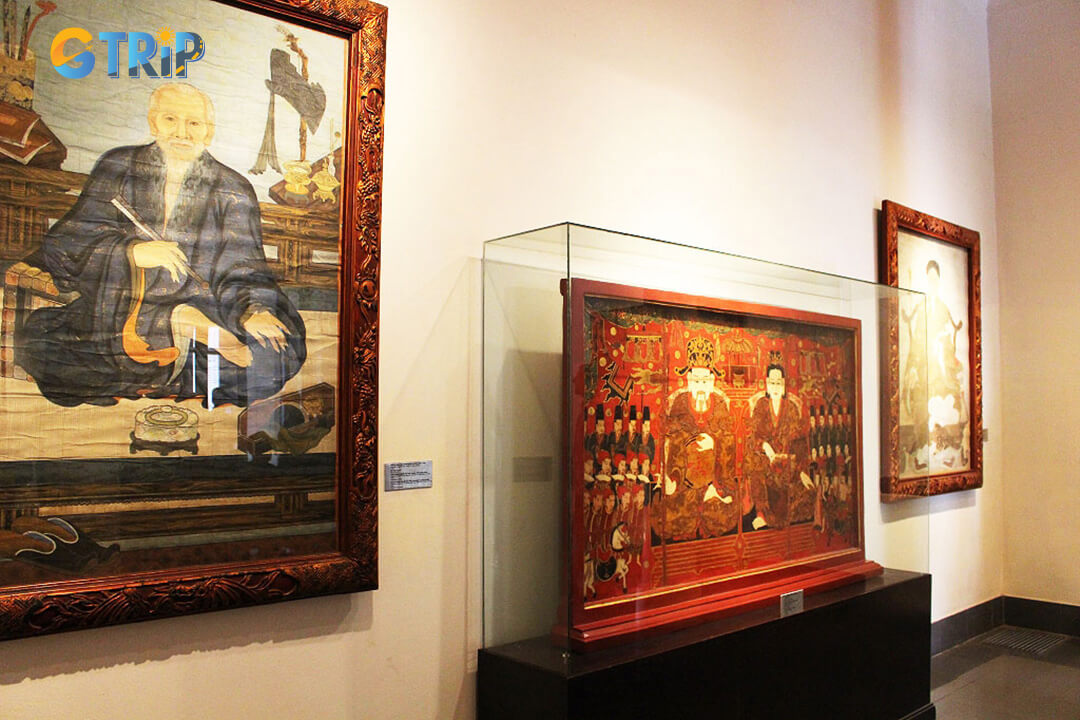
This gallery highlights the evolution of Vietnamese sculpture, from refined religious art of the Ly-Tran era to folk-inspired carvings of later dynasties
Modern and contemporary art from the 20th century to the present
The Vietnam National Fine Arts Museum’s modern and contemporary art exhibition covers the period from the 20th century to the present. It is divided into two main sections. The first section displays works according to historical art periods: 1925 to 1945, and 1945 to 1954. The second section showcases works by medium. This includes collections of lacquer painting, silk painting, oil painting, graphic art, and sculpture from 1954 to the present.
- Vietnamese Art from 1925 to 1945: This period marks a new era in the history of modern Vietnamese art with the establishment of the Indochina Fine Arts College. Artists and sculptors emerged with their preferred materials and themes, creating distinctive marks in later modern and contemporary art. The two main artistic trends were romanticism and realism.
- Vietnamese Art from 1945 to 1954: During the nine years of resistance against the French, the sketch collections show a shift in artists’ concepts, connecting art closely with national upheaval. Artists abandoned romantic styles for optimistic, combative works, forming the foundation of revolutionary resistance art that continues today.
- Art from 1954 to present: Collections are organized by medium: lacquer, silk, oil painting, graphic art, and sculpture.
- The lacquer collection features hundreds of key works representing different creative phases of generations of artists, helping to shape a modern national art identity. The lacquer paintings are among the museum’s most valuable curated collections.
- The silk painting collection is significant within the museum’s overall works, deeply reflecting a uniquely Vietnamese identity. Its subtle, gentle, and profound East Asian artistic charm contributes to the national cultural heritage.
- The oil painting collection showcases works created after 1954, expressing sincere emotions about the country and its people during war and nation-building. Notable pieces from the 1980s display symbolic language, unusual compositions, and bright expressive colors. Works from the 1990s reveal a strong explosion of modern art trends: realism, impressionism, expressionism, abstraction, surrealism, and more.
- The graphic art collection includes diverse materials such as pastel, watercolor, printmaking, and chalk.
- The modern sculpture collection records important milestones in each art development phase, reflecting subtle beauty without strict realism, creating profound authenticity in every work.
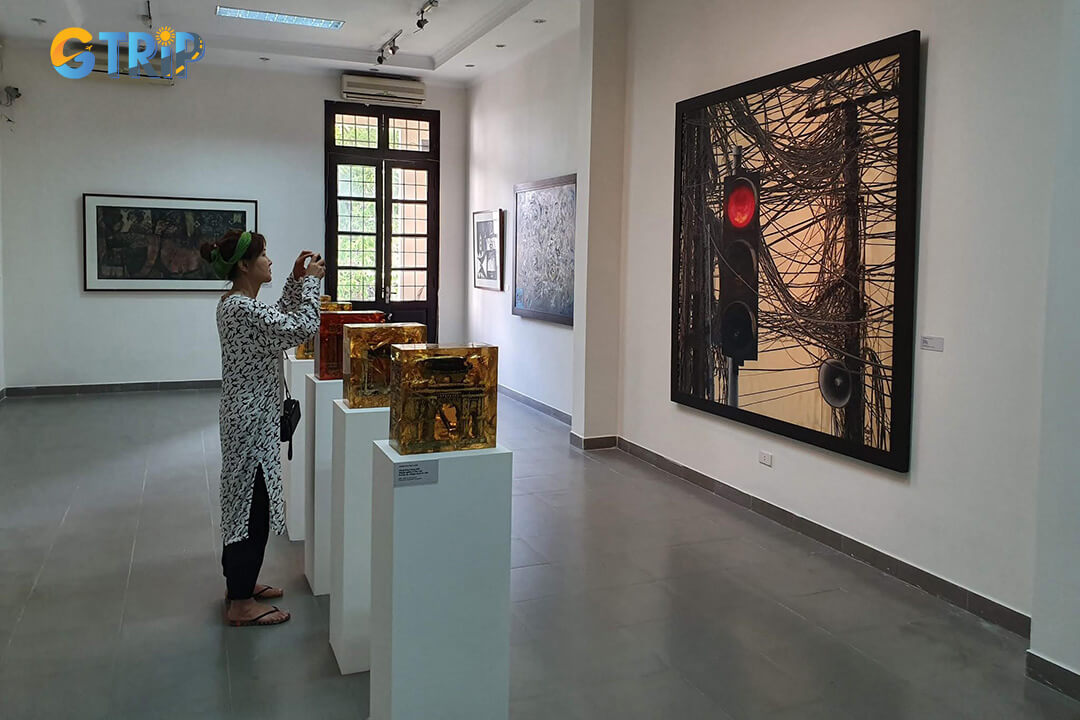
The modern and contemporary art section highlights Vietnam’s artistic evolution from 1925 to today through historical periods
Traditional applied arts
Artisans across the country have respectfully infused artistic values into all kinds of objects. These include household tools, production equipment, clothing, housing, musical instruments, and items used in rituals, religious practices, and folk stage performances. Here, we encounter a full range of handcrafted techniques expressed on every material available in Vietnam, showcasing a level of craftsmanship worthy of pride. The remarkable diversity in materials includes bamboo, woven fabrics, mother-of-pearl inlay, metal engraving, and more. This variety demonstrates the practical nature of the artifacts collected and displayed here.
Folk art
Folk art constitutes a vital element of the nation’s cultural and artistic heritage. The Vietnam National Fine Arts Museum’s specialised folk art collection primarily highlights two prominent categories: folk paintings and folk sculptures.
Folk paintings boast a long-standing history, with significant development occurring around the 16th century during the Mac dynasty. Despite many historical changes, Vietnamese folk paintings have kept their vividness and rich themes, including auspicious wishes, daily life, history, and worship. While thematic focuses shift across different eras, they consistently emphasize aspects of everyday life, spirituality, culture, and the national spirit of resilience and development. These artworks honor culture, reject social vices and foreign influences, celebrate war heroes, and commemorate national achievements. Folk paintings and sculptures meet the spiritual and aesthetic needs of working people during festivals. Additionally, they embed moral and ethical teachings applicable to everyday life.
Folk paintings have been produced extensively across various regions nationwide. They are classified into several schools based on content, technique, style, and materials. Each school is named after its place of origin, such as Dong Ho paintings (Bac Ninh Province), Hang Trong paintings (Hanoi), Kim Hoang paintings (Hanoi), Lang Sinh paintings (Thua Thien Hue), and worship paintings from the Kinh and various northern ethnic minorities. Among these, Dong Ho and Hang Trong stand out, with deep local traditions and distinct rural and urban aesthetics.
Vietnamese folk sculpture is equally diverse and rich, encompassing terracotta modeling, wood carving, and metalwork. The sculptures cover a wide range of themes that vividly evoke the lives, customs, and traditions of different ethnic groups throughout various historical periods.
Exploring folk art reveals its beauty and offers insight into the nation's history and culture. Vietnamese folk art is vibrant, reflecting the heartfelt emotions and skilled craftsmanship of its people. Cherished, preserved, and transmitted across generations, folk art makes a substantial contribution to the national artistic legacy.

The folk art section celebrates Vietnam’s cultural heritage through vivid paintings and diverse sculptures that reflect daily life, spirituality
Ceramics collection (from the 11th to the 20th century)
The exhibition hall "Vietnamese Ceramic Art from the 11th to the 20th Century" showcases the most distinctive features of both unglazed and glazed ceramics across different periods. Celadon and crackled glaze ceramics are typical products of the Ly dynasty (11th - 12th centuries). These pieces are decorated mainly with stylized motifs such as lotus, chrysanthemum, hibiscus flowers, crabs, fish, clouds, and water waves.
Brown-painted ceramics emerged in the late 12th century but stabilised in style during the 13th - 14th centuries under the Tran dynasty, becoming a hallmark ceramic line. The decorative themes are drawn from everyday life and include cloud patterns, flowers, birds, fish, tigers, and elephants. Brown-painted ceramics show a simple, rustic quality yet possess high artistic value.
Blue-and-white ceramics began to appear around the late 14th century. However, it was not until the 15th century under the Early Le dynasty that they flourished and dominated for five centuries, spanning the Le, Mac, Later Le, Tay Son, and Nguyen dynasties. Blue-and-white ceramics display great variety in size, type, shape, and decoration themes.
In the early 20th century, several household ceramic workshops across the North, Central, and South regions continued producing ceramics for daily use. Skilled artisans combined traditional techniques with modern ideas, transforming the appearance of both household and artistic ceramics. Today, Vietnamese ceramics are favored both domestically and internationally, with promising prospects for even greater achievements in the future.
6 things to do at the Vietnam National Fine Arts Museum
The Vietnam National Fine Arts Museum offers visitors not just a passive viewing experience but a rich array of activities that engage all senses. The museum offers masterpieces, hands-on workshops, photography spots, and culinary breaks for a full experience of Vietnam’s artistic heritage.
1. Explore the permanent collection of over 2,000 items
The museum houses an impressive permanent collection featuring more than 2,000 meticulously curated artworks spanning Vietnam's rich artistic history. As you wander through the exhibition halls, you'll encounter stunning silk paintings that capture traditional Vietnamese life with delicate brushwork and subtle color palettes.
The lacquerwork displays showcase one of Vietnam's most distinctive art forms. These pieces feature intricate inlays of mother-of-pearl, eggshell, and gold leaf on glossy surfaces that seem to glow from within. Many visitors are captivated by the ceramic collection, showcasing pottery's evolution from primitive earthenware to refined glazed ceramics.
The sculpture collection presents works in diverse materials, including wood, stone, and bronze, depicting everything from religious icons to scenes from daily life. Each gallery is arranged chronologically to showcase the evolution of Vietnamese art influenced by Chinese, French, and local traditions.
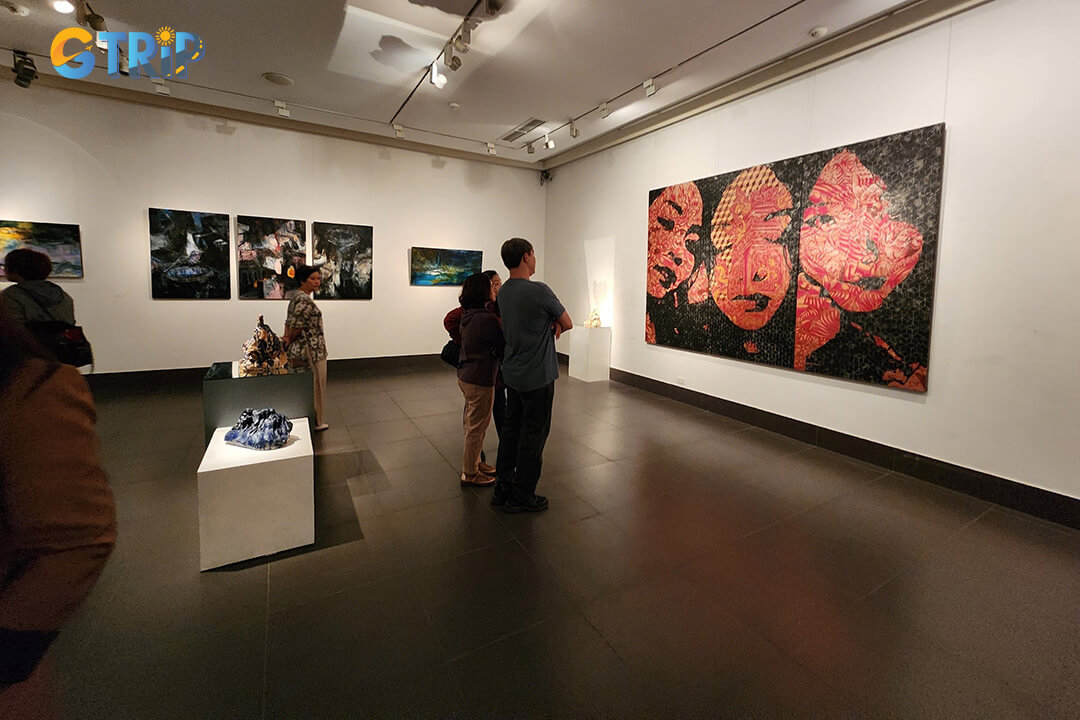
The museum’s permanent collection features over 2,000 artworks showcasing Vietnam’s artistic evolution through silk paintings, lacquerware, ceramics
2. Participate in hands-on art activities at the Creative Space for children
The Creative Space for children, opened in 2011 on the third floor, lets young visitors develop artistic skills through hands-on activities. This dedicated area transforms the museum visit from a passive experience into an interactive artistic adventure that children eagerly anticipate. Art educators guide children in lacquer painting, sculpture, and collage, offering hands-on fun with real materials and Vietnamese art traditions.
Parents appreciate how the space introduces children to both traditional folk art motifs and contemporary Vietnamese artistic movements. The accessible pricing makes this cultural activity affordable for both local families and tourists seeking enriching experiences for their children. This engaging environment inspires creativity while fostering a deeper appreciation for Vietnam’s rich artistic heritage.
3. Take photographs in the museum's artistic spaces
The museum’s French colonial architecture offers a stunning, historic backdrop perfect for photography. Natural light streams through strategically placed windows in many galleries, creating dramatic lighting conditions that highlight the textures and colors of the artworks on display.
Photographing the permanent collection is generally allowed without flash. However, always check with staff about rules for temporary exhibitions or delicate artifacts. The museum’s central courtyard, with its sculptural installations and seasonal plants, offers fresh photo opportunities year-round.
Many visitors find creative inspiration in capturing the juxtaposition between the historic building and the contemporary art displays. The third-floor balconies provide excellent vantage points for architectural photography, revealing interesting perspectives of the museum's interior spaces. They also offer glimpses of Hanoi's urban landscape beyond.
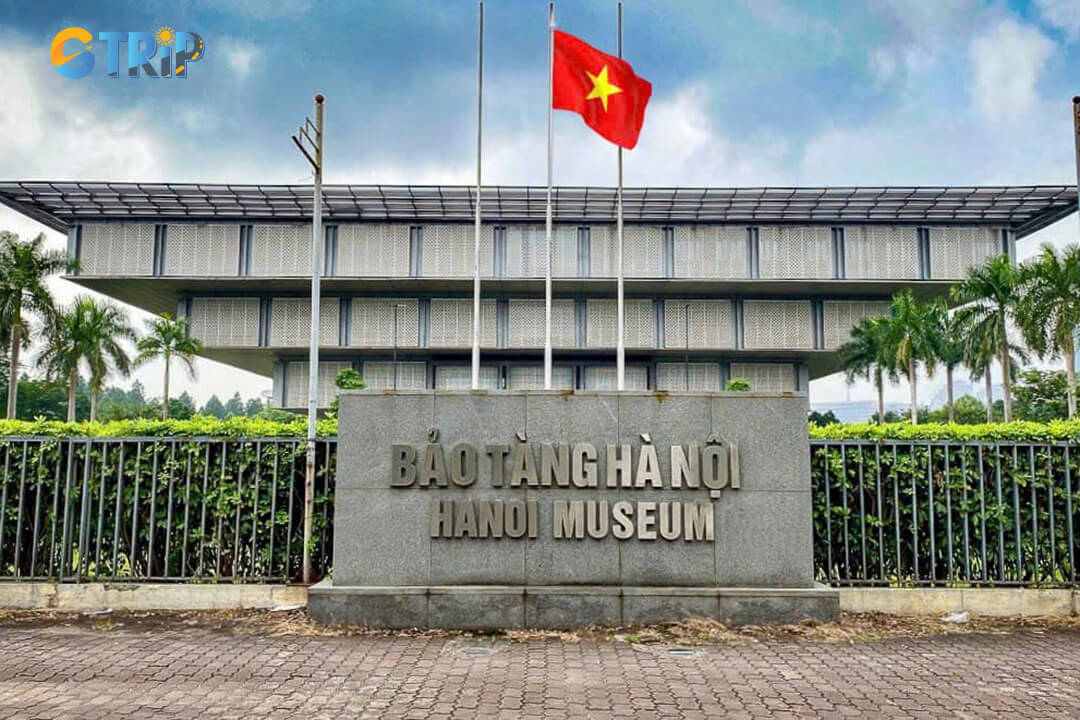
The museum’s French colonial architecture, abundant natural light, and diverse indoor and outdoor spaces create ideal settings for photography
4. Enjoy coffee and refreshments at the on-site lounge
The museum's charming cafe provides a welcome respite after hours of artistic exploration, offering comfortable seating in a light-filled space adorned with replica artworks. Traditional Vietnamese coffee preparations, including the rich, condensed-milk sweetened “ca phe sua da”, are served alongside international coffee options like espresso and cappuccino.
The refreshment menu features local specialties such as banh chung (sticky rice cakes) and seasonal fruit platters that introduce visitors to Vietnamese culinary traditions. Large windows overlooking the museum gardens create a tranquil atmosphere where you can reflect on the artworks you've experienced while resting tired feet.
Cafe details:
- Hours: 9:00 AM - 10:30 PM
- Price range: 30,000 - 70,000 VND for beverages
- Specialties: Vietnamese coffee, local tea varieties, light snacks
- Seating: Indoor air-conditioned area and seasonal outdoor seating
- Accessibility: Located on the ground floor near the gift shop
5. View works by famous Vietnamese artists
The museum features masterpieces by Vietnam’s top artists, including Nguyen Gia Tri’s groundbreaking lacquer paintings blending tradition with modern themes. To Ngoc Van's poignant portraits capture the essence of Vietnam during its revolutionary period, combining Western painting techniques with distinctly Vietnamese subjects. Tran Van Can's work exemplifies the socialist realist style while maintaining uniquely Vietnamese sensibilities in composition and subject matter. Nguyen Phan Chanh’s silk paintings of rural life captivate with emotional depth and refined minimalism. The museum provides informative context about each artist's historical significance and contribution to Vietnam's artistic evolution. Dedicated galleries trace artists’ careers and major art movements, offering insight into Vietnam’s evolving art through its turbulent history.
Notable artists and their contributions:
- Nguyen Gia Tri: Pioneered modern lacquer painting techniques
- To Ngoc Van: Merged Western and Eastern influences in revolutionary-era portraiture
- Tran Van Can: Developed Vietnamese socialist realism with cultural sensitivity
- Nguyen Phan Chanh: Elevated silk painting to fine art status with rural life themes
- Luong Xuan Nhi: Created distinctive landscape styles blending traditional and modern elements
6. Explore the museum with 3D Tour
Clicking on any exhibit or area in the tour brings up detailed information panels about the artwork, including its title, materials, date, origin, and description. All content is available in both Vietnamese and English. This is an excellent tool for teachers, students, researchers, and art enthusiasts to learn and explore in a visual, engaging, and convenient way.
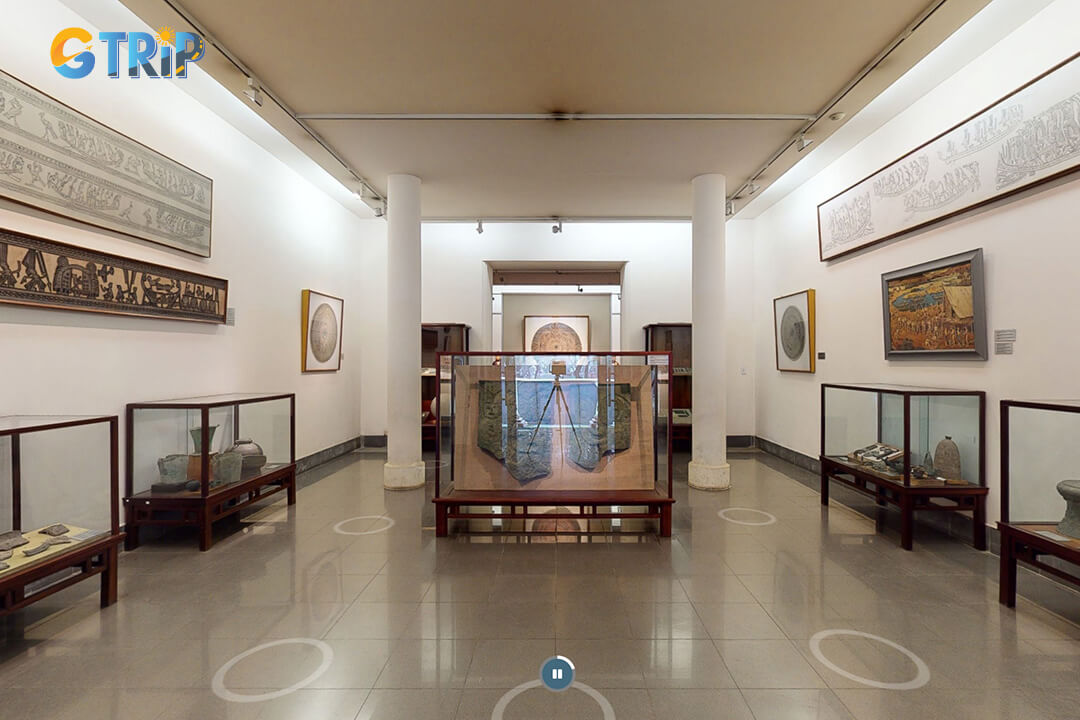
The museum’s immersive 3D virtual tour offers interactive, detailed exploration of exhibitions anytime, anywhere, with multilingual information accessible online
How to get to the Vietnam National Fine Arts Museum?
Located at 66 Nguyen Thai Hoc Street in Ba Dinh District, the Vietnam National Fine Arts Museum is conveniently accessible via multiple transportation options. If you're staying in Hanoi's Old Quarter or elsewhere in the city, reaching this cultural gem is straightforward. Here's a comprehensive guide on various transportation methods to help you plan your visit efficiently.
By bus
The public bus system offers perhaps the most economical way to reach the museum, making it ideal for budget travelers and those looking to experience local transportation:
- Route 09: Connects the Old Quarter with Ba Dinh district, stopping near Hanoi Railway Station
- Route 14: Runs between Phu Thuong and Giap Bat areas, passing through central districts
- Route 22: Links Long Bien Bus Station with Yen Nghia, passing near the museum
- Route 32: Connects My Dinh Bus Station with Hanoi's central areas
When taking the bus, look for stops near the Temple of Literature, which sits directly across from the museum. Bus fares are extremely affordable at approximately 7,000 - 9,000 VND (about $0.30 - $0.40) per ride, making this the most cost-effective option for budget-conscious travelers.
By taxi
For visitors prioritizing convenience, especially those traveling in groups or carrying luggage, taxis provide direct access to the museum's entrance:
| Taxi company | Fare range | Features | Contact |
|---|---|---|---|
| Vinasun Taxi | 11,000 - 15,000 VND/km | Metered, English-speaking drivers available | 18001818 |
| Mai Linh | 11,000 - 15,000 VND/km | Reliable meter system, green vehicles | 1055 |
| Xanh SM | 11,000 - 15,000 VND/km | Electric vehicles, app-booking available | Via the Grab app |
| Hanoi Tourist | 10,000 - 12,000 VND/km | Tourism-specialised service, English support | 024 3926 3333 |
Most taxis from central Hanoi districts will cost between 40,000 - 80,000 VND (approximately $1.70 - $3.40) depending on your starting location. Always ensure the driver uses the meter or agrees on a price before departing.
By bicycle
Exploring Hanoi by bicycle offers a charming and flexible way to discover the city while reaching the museum:
- Basic bicycle rentals range from 40,000 - 70,000 VND ($1.70 - $3.00) for a full day
- Many hotels and hostels provide bicycle rentals for guests at competitive rates
- Bike-sharing services like Mobike are also available in central areas
Cycling to the museum is relatively straightforward from most central locations, with the journey from the Old Quarter taking approximately 15 - 20 minutes. The museum provides bicycle parking facilities, making this an environmentally friendly and enjoyable transportation option for those comfortable navigating Hanoi's streets.
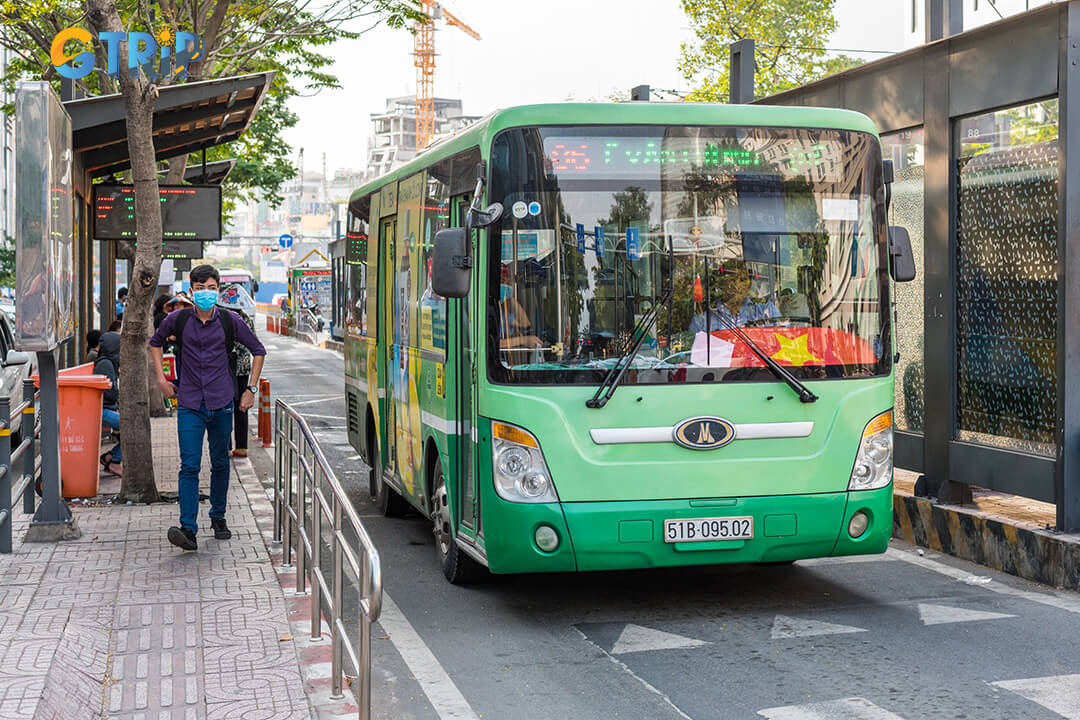
Vietnam National Fine Arts Museum is easily accessible from Hanoi’s Old Quarter and beyond via multiple transportation options
Important notes when visiting the Vietnam National Fine Arts Museum
To fully enjoy your cultural experience while respecting this significant institution, visitors should be aware of several important guidelines. The Vietnam National Fine Arts Museum maintains specific protocols to preserve its valuable collections and ensure a pleasant experience for all guests. Here's what you need to know before your visit:
Visitor etiquette and dress code
When entering this cultural treasure house of Vietnamese art, proper etiquette is essential. The museum environment demands respect, starting with your appearance:
- Appropriate attire is required throughout your visit, modest clothing that covers shoulders and knees is recommended
- Quiet conversation is expected, keep voices low to maintain the contemplative atmosphere
- Mobile phones should be set to silent mode during your tour
- Respectful behavior toward staff, other visitors, and the cultural significance of the space is mandatory
Many international visitors appreciate that the dress code is more relaxed than at religious sites. However, it still preserves the dignified atmosphere expected at Vietnam's premier art institution.
Practical regulations and safety measures
The museum enforces several practical rules that ensure both the safety of the artifacts and visitors:
| Regulation | Details |
|---|---|
| Prohibited items | Weapons, explosives, flammable materials, hazardous substances |
| Luggage storage | All backpacks, suitcases, and large bags must be stored in designated areas |
| Valuables | Do not leave money or important items in stored luggage |
| Food & drinks | Not permitted in exhibition rooms |
| Parking | Use only designated visitor parking areas |
Note: You should note that security checks may be conducted at the entrance, particularly during peak tourist seasons or special exhibitions.
Artifact preservation guidelines
The museum houses irreplaceable artistic treasures spanning centuries of Vietnamese cultural development:
- Strict no-touch policy for all exhibits and display cases
- Flash photography is prohibited to prevent light damage to sensitive artworks
- Professional photography or filming requires pre-registration and payment of fees
- Personal photos with smartphones are generally allowed for non-commercial use
- Maintaining distance from paintings and sculptures (approximately 1 meter) is required
Museum services and assistance
For an enhanced experience, the museum offers several supportive services:
- Guided tours are available upon request at the guide desk (House 1) or ticket counter
- Audio guides in multiple languages can be rented for self-guided exploration
- Official guides wear identification badges - always verify credentials
- Information brochures are available in Vietnamese, English, French, and several other languages
- Staff assistance for visitors with special needs or accessibility requirements
Following these guidelines helps preserve the Vietnam National Fine Arts Museum as a vibrant cultural institution for future generations. It also ensures an enriching experience for all visitors.
Nearby attractions from the Vietnam National Fine Arts Museum
After exploring the museum, visitors can easily walk to several nearby historical landmarks that offer deeper insights into Vietnam’s rich cultural heritage.
Hanoi Flag Tower
Hanoi Flag Tower stands as one of the capital's most iconic symbols and is just a short 10-minute walk from the Fine Arts Museum. Built in 1812 during the Nguyen Dynasty, this 33-meter-tall structure has witnessed Vietnam's tumultuous history and remained standing through wars and conflicts. The tower features classical Vietnamese design elements with its octagonal base and tiered structure that narrows toward the top.
Visitors can enjoy:
- Spectacular views of central Hanoi from the surrounding park
- Photography opportunities of the massive Vietnamese flag waving atop the tower
- Peaceful walking paths through the adjacent Lenin Park
- Historical displays documenting the tower's significance during the American War
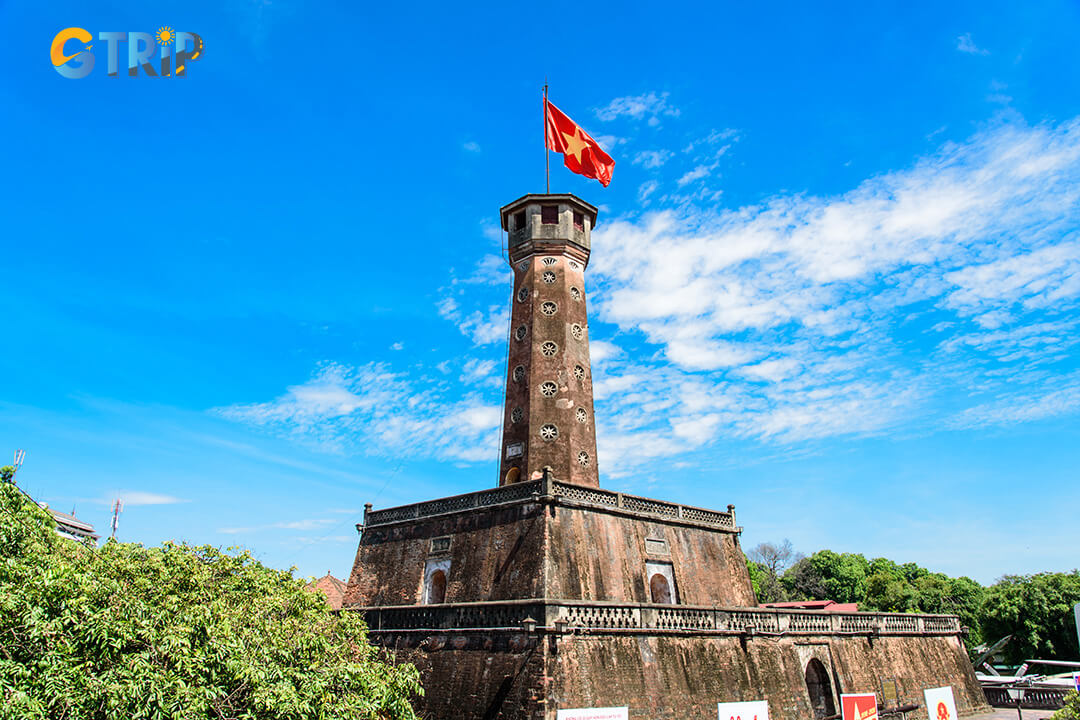
Hanoi Flag Tower is a historic 33-meter monument from 1812 offering panoramic views, rich history, and a peaceful park setting near the Fine Arts Museum
Temple of Literature
Temple of Literature lies approximately 15 minutes on foot from the Fine Arts Museum and represents Vietnam's first national university. Founded in 1070 during the Ly Dynasty, this ancient Confucian temple honors scholars. It houses stone stelae mounted on tortoises, inscribed with the names of successful doctoral candidates from 1442 to 1779. The complex exemplifies traditional Vietnamese architecture with its series of five courtyards, each representing a different stage in the journey toward enlightenment.
| Courtyard | Significance | Key Features |
|---|---|---|
| First | Entrance to the path of learning | Great Portico, ornamental gates |
| Second | Refreshing the mind | Khue Van Pavilion, symbol of Hanoi |
| Third | Quiet contemplation | Thien Quang well, stone doctor stelae |
| Fourth | Altars to Confucius | Place of ceremonies and worship |
| Fifth | Imperial Academy | Vietnam's first university location |
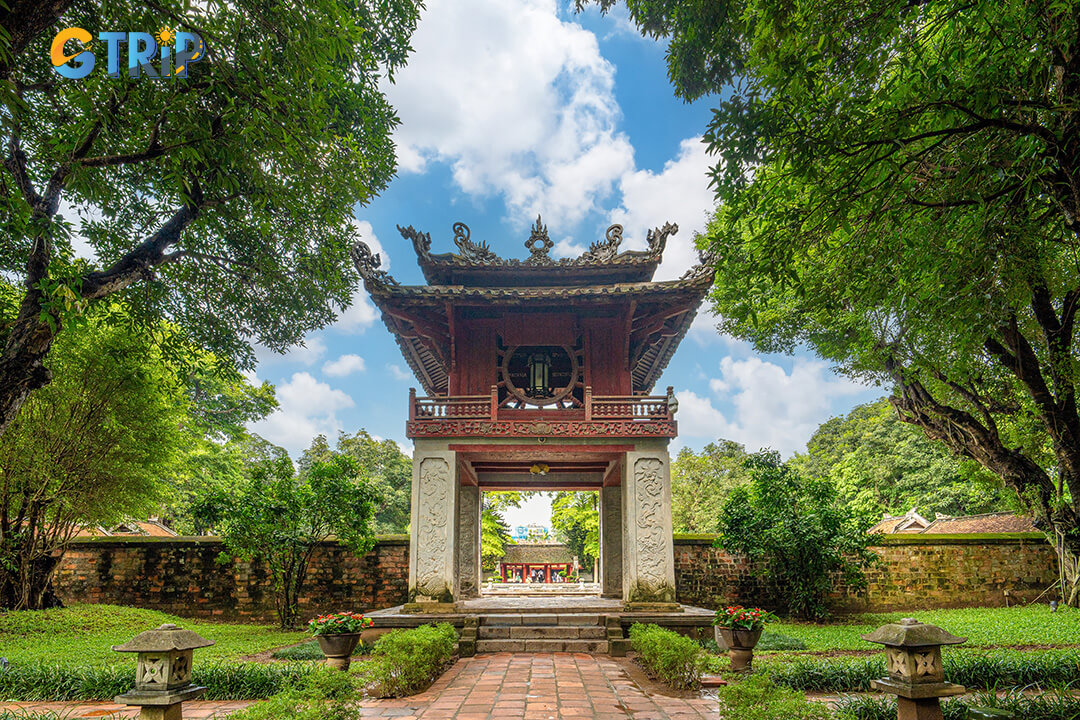
Temple of Literature, near the Fine Arts Museum, showcase historic landmarks with rich culture and beautiful architecture
Hanoi Train Street
Hanoi Train Street is located around 850m from the Fine Arts Museum. This narrow residential alley features homes built unusually close to active train tracks, creating a unique urban phenomenon. Trains roar through this crowded neighborhood several times daily, passing inches from doorsteps and forcing people to press against walls. While the original section on Tran Phu street has been restricted due to overtourism, you can still experience this unusual sight at alternative spots along the train route.
For the best experience:
- Check train schedules in advance (typically around 3:00 PM and 7:00 PM)
- Visit the alternative viewing spots at Phung Hung Street or Le Duan Street
- Respect residents, as this is their neighborhood
- Try coffee at one of the small cafes that have adapted to this unique environment
- Maintain a safe distance from the tracks when trains approach
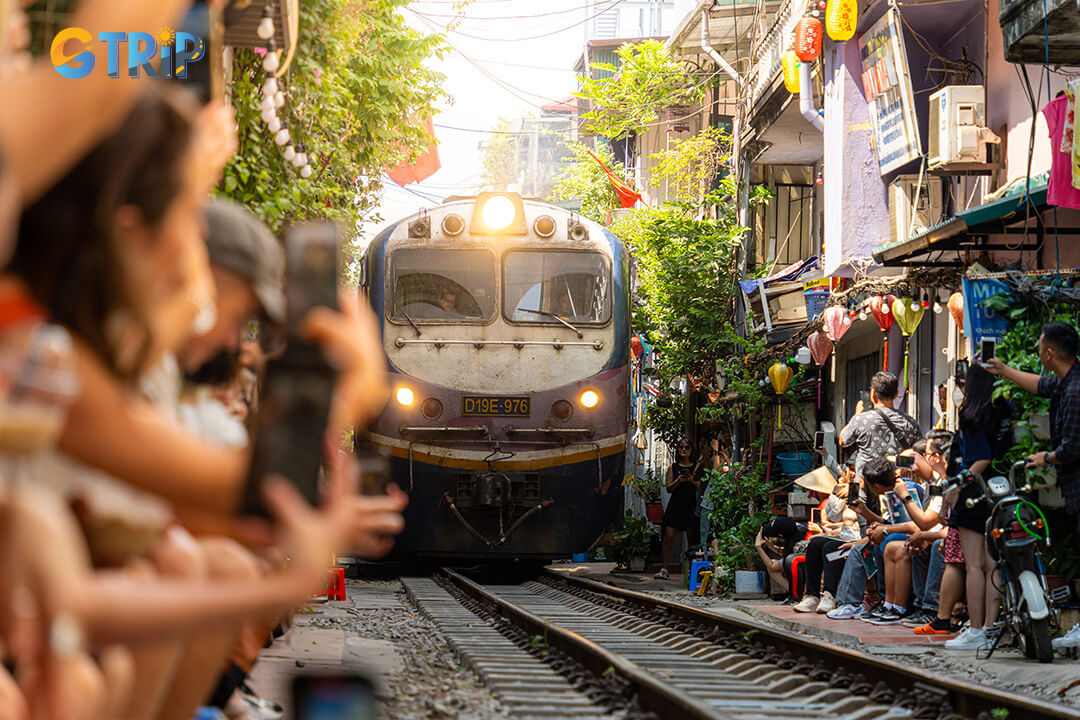
Train Street is a unique urban spot where trains pass inches from homes, offering a thrilling experience best enjoyed at alternative viewing points while respecting residents
Imperial Citadel of Thang Long
Imperial Citadel of Thang Long lies just a 12-minute walk from the Fine Arts Museum and represents over 1,300 years of Vietnamese history. Recognized as a UNESCO World Heritage Site in 2010, this massive complex served as the political center of Vietnam for 13 consecutive centuries. Excavations have revealed artifacts from multiple dynasties, providing a layered archaeological record of the nation's development. The site includes:
- Doan Mon Gate - The main southern entrance to the royal palace
- Kinh Thien Palace foundations - Tnce the most important building in the citadel
- Building D67 - The Vietnam War headquarters for the Vietnamese People's Army
- Underground bunkers with original military equipment and maps
- Archaeological zones displaying artifacts from different historical periods
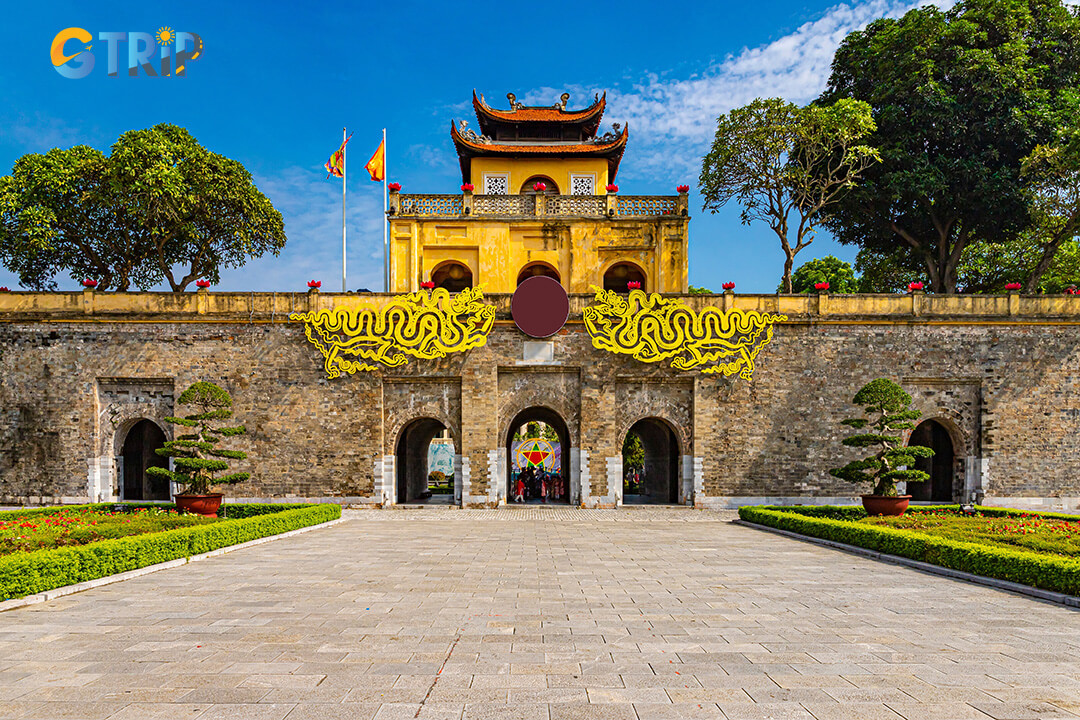
The Imperial Citadel showcases 1,300 years of Vietnamese history with royal gates, palace ruins, and war headquarters
Complex of Ho Chi Minh
Just a 15-minute walk from the museum, the Ho Chi Minh Complex honors Vietnam's revered revolutionary leader. The complex includes Ho Chi Minh's Mausoleum and his humble stilt house, reflecting his simple lifestyle despite national prominence. The Presidential Palace, built in colonial French style, stands nearby but was never used by Ho Chi Minh himself, who preferred more modest accommodations.
Key components include:
- Ho Chi Minh Mausoleum - Where visitors can pay respects to the preserved body of "Uncle Ho"
- Presidential Palace - An impressive yellow structure built in 1900 for the French Governor-General
- Ho Chi Minh's Stilt House - A simple wooden structure reflecting his humble lifestyle
- One Pillar Pagoda - A unique Buddhist temple rebuilt after being destroyed during the French withdrawal
- Ho Chi Minh Museum - Housing exhibits on his life and Vietnam's revolutionary struggle
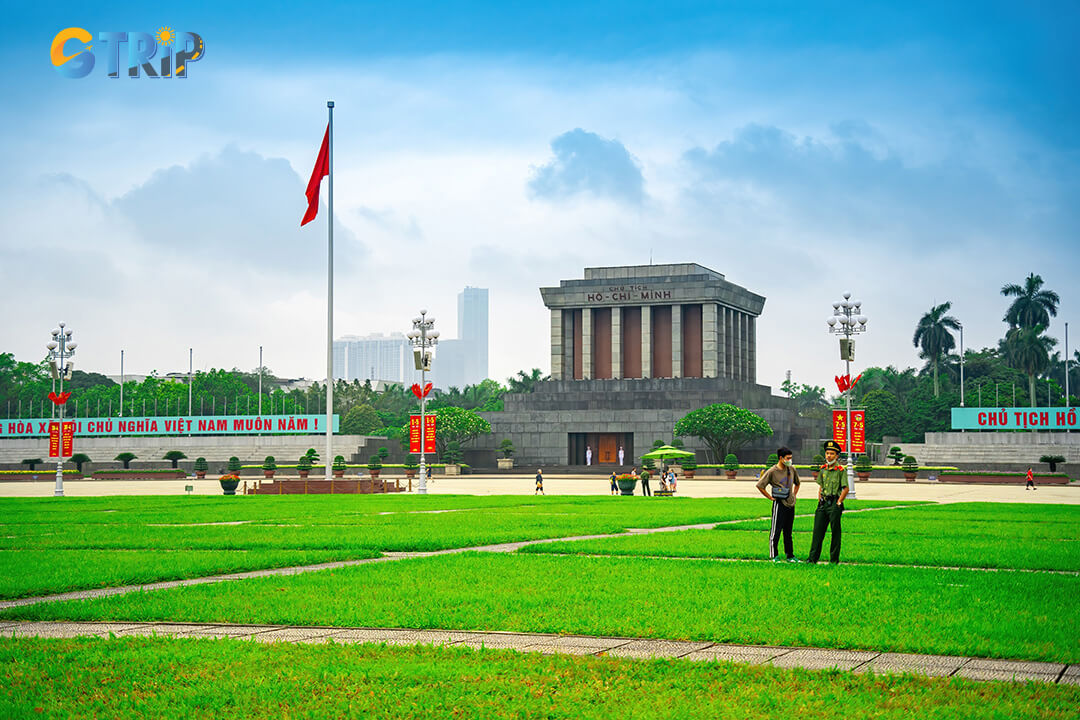
The Ho Chi Minh Complex, 15 minutes from the museum, features the Ho Chi Minh Mausoleum, stilt house, Presidential Palace, pagoda, and museum
Exploring the Vietnam National Fine Arts Museum leaves you with a deeper appreciation for the country's vibrant artistic heritage. Exploring traditional to modern art deepens your connection to Vietnam's cultural spirit. This journey through art has offered fresh perspectives, inviting contemplation and inspiration.
As you reflect on your virtual visit, envision translating these new insights into your travel plans or sharing them in conversations about art and culture. If you're yearning for more, consider diving deeper into related narratives or resources that can expand this newfound interest further. The complex includes Ho Chi Minh's Mausoleum and his humble stilt house, reflecting his simple lifestyle despite national prominence.

